Angel Fish - Dwarf
Flame Angelfish (Centropyge loriculus)
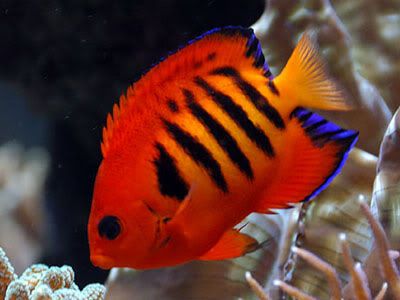
QUICK STATS
Minimum Tank Size: 30 gallons
Care Level: Moderate
Temperament: Semi-aggressive
Reef Compatible: With Caution
Water Conditions: 72-78F, dKH 8-12, pH 8.1-8.4, sg 1.020-1.025
Max. Size: 4"
Color Form: Blue, Orange, Yellow
Diet: Omnivore
Compatibility: View Chart
Origin: Cebu, Christmas Island, Marshall Islands, Tahiti, Vanuatu
Family: Pomacanthidae
OVERVIEW
The Flame Angelfish is a flashy addition to many aquariums. One of the most popular of the dwarf angelfish, the Flame Angelfish is a bold red/orange color with vertical black stripes highlighting the body and horizontal black stripes along the caudal portions of the blue-tipped dorsal and anal fins.
The Flame Angelfish requires at least a 30-gallon aquarium with lots of hiding places and live rock for grazing. The Flame Angelfish is prone to nip at stony and soft corals (sessile invertebrates) and clam mantles. If the Flame Angelfish is to be added to a peaceful community, it should be the last fish introduced. The Flame Angelfish adapts well to aquarium life, but should be kept in an established system and housed with dissimilar genera. The Flame Angel is very sensitive to elevated levels of copper, and should never be exposed to levels near or above 0.15 ppm.
The Flame Angelfish is hermaphroditic, very difficult to breed in an aquarium, and has no distinguishable differences in color between male to female.
The diet of the Flame Angelfish should consist of Spirulina, marine algae, high-quality angelfish preparations, mysis or frozen shrimp, and other high-quality meaty items.
There are slight differences in both coloration and markings of this species based on the location of collection. Flame Angelfish from the Central Pacific include both Marshall Islands and Christmas Island. Marshall Island Flame Angelfish are redder in color, with thicker black bars running vertically down the body. Christmas Island Flame Angelfish are normally red/orange coloration with thin black bars running vertically down the body. Flame Angelfish from Cebu are red/orange with undefined black bars and a tint of yellow in between the bars. Flame Angelfish from Tahiti are rarely collected and are blood red in coloration and possess very little to no yellow. It is important to note that these color descriptions are a general guideline. Please expect variation among each fish. The price differences between different varieties reflect the difference in collection, transportation and importation expense.
Coral Beauty Angelfish (Centropyge bispinosus)
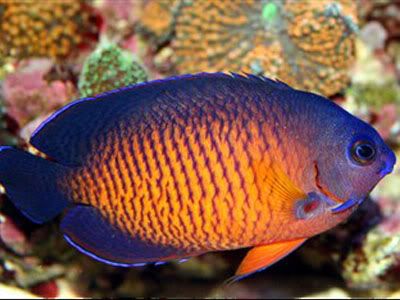
QUICK STATS
Minimum Tank Size: 30 gallons
Care Level: Easy
Temperament: Semi-aggressive
Reef Compatible: With Caution
Water Conditions: 72-78F, dKH 8-12, pH 8.1-8.4, sg 1.020-1.025
Max. Size: 4"
Color Form: Blue, Orange, Yellow
Diet: Omnivore
Compatibility: View Chart
Origin: Fiji, Indonesia, Vanuatu
Family: Pomacanthidae
OVERVIEW
Very common on the Great Barrier Reef, the Coral Beauty Angelfish is also known as the Twospined or Dusky Angelfish. The body and head are a deep royal blue, highlighted with an iridescent orange to yellow. The Coral Beauty Angelfish is one of the easiest angels to care for.
It requires a 30 gallon or larger tank with lots of hiding places and live rock for grazing. Not a good reef dweller, the Coral Beauty Angelfish is prone to nip at stony and soft corals (sessile invertebrates).
The diet of the Coral Beauty Angelfish should consist of Spirulina, marine algae, high-quality angelfish preparations, mysis or frozen shrimp, and other quality meaty foods.
Bicolor Angelfish (Centropyge bicolor)

QUICK STATS
Minimum Tank Size: 30 gallons
Care Level: Moderate
Temperament: Semi-aggressive
Reef Compatible: With Caution
Water Conditions: 72-78F, dKH 8-12, pH 8.1-8.4, sg 1.020-1.025
Max. Size: 6"
Color Form: Blue, Yellow
Diet: Omnivore
Compatibility: View Chart
Origin: Fiji, New Caledonia, Papua New Guinea
Family: Pomacanthidae
OVERVIEW
Thought by many to be the most striking of the Centropyge group of dwarf or pygmy angelfish, the Bicolor Angelfish, also known as the Two-colored Angelfish or Oriole Angelfish, is a vibrant yellow on the anterior half of its body and a deep blue on the posterior half. A splash of deep blue extends upward vertically from the eye to the top of the head and the tail is yellow.
A minimum of a 30 gallon tank with lots of hiding places and live rock for grazing will offer an environment in which to thrive. Not a good reef dweller, the Bicolor Angelfish is prone to nip at stony and soft corals (sessile invertebrates) and clam mantles.
It is hermaphroditic, very difficult to breed in an aquarium, and has no distinguishable differences in color between male to female. The Bicolor Angelfish requires a diet of Spirulina, marine algae, high-quality angelfish preparations, and mysis or frozen shrimp.
Lemonpeel Angelfish (Centropyge flavissima)

QUICK STATS
Minimum Tank Size: 30 gallons
Care Level: Moderate
Temperament: Semi-aggressive
Reef Compatible: With Caution
Water Conditions: 72-78F, dKH 8-12, pH 8.1-8.4, sg 1.021-1.025
Max. Size: 6"
Color Form: Yellow
Diet: Omnivore
Compatibility: View Chart
Origin: Fiji, Vanuatu
Family: Pomacanthidae
OVERVIEW
The Lemonpeel Angelfish is a cheery yellow with sky-blue highlights on the lips, encircling the eyes, on the pectoral fins, and the tips of the dorsal, caudal, and anal fins. To avoid confusion with the False Lemonpeel Angelfish (C. heraldi) that lacks the blue highlights, this angelfish is also referred to as the True Lemonpeel Angelfish.
The Lemonpeel Angelfish requires a 30 gallon or larger aquarium with hiding places and large amounts of live rock to graze on the microalgae growth. It is very prone to nip at large-polyped stony corals and clam mantles. It is best not to keep Lemonpeel Angelfish with fish of the same genera.
The diet of the Lemonpeel Angelfish should include Spirulina, marine algae, high-quality angelfish preparations, mysis or frozen shrimp, and other meaty items. This angelfish requires more algae and seaweed in its diet than most angels.
Multicolor Angelfish (Centropyge multicolor)
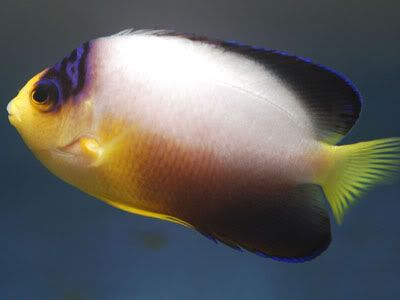
QUICK STATS
Minimum Tank Size: 30 gallons
Care Level: Moderate
Temperament: Semi-aggressive
Reef Compatible: With Caution
Water Conditions: 72-78F, dKH 8-12, pH 8.1-8.4, sg 1.020-1.025
Max. Size: 3.5"
Color Form: Black, Blue, Orange, White, Yellow
Diet: Omnivore
Compatibility: View Chart
Origin: Marshall Islands
Family: Pomacanthidae
OVERVIEW
The Multicolor Angelfish, also known as the Pastel Pygmy Angelfish or Many-colored Angelfish, is pale peach-orange to yellow. Black speckles on a background of blue highlight an area just behind the eyes. The dorsal and anal fins are blue-black while the caudal fin is yellow. In bright contrast to its other colors, there is a horizontal swatch of silvery-white from mid-body to the caudal fin.
The Multicolor Angelfish needs a minimum of a 30 gallon tank with lots of hiding places and live rock for grazing on microalgae. It does best in subdued lighting, since in the wild, it is a deep-water swimmer. If the Multicolor Angelfish is to be housed with other dwarf angels, a 55 gallon or larger tank is required. Not a good reef dweller, the Multicolor Angelfish is prone to nip at stony and soft corals (sessile invertebrates) and clam mantles. It is sensitive to copper-based medications.
The diet of the Multicolor Angelfish should include Spirulina, high-quality angelfish preparations, mysis or frozen shrimp, and other high-quality meaty items.
Red Stripe Angelfish (Centropyge eibli)
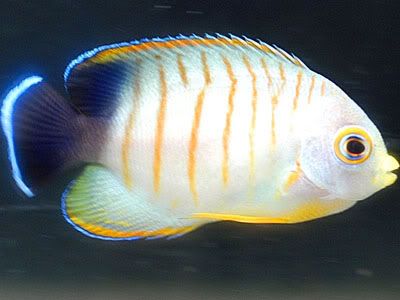
QUICK STATS
Minimum Tank Size: 30 gallons
Care Level: Moderate
Temperament: Semi-aggressive
Reef Compatible: With Caution
Water Conditions: 72-78F, dKH 8-12, pH 8.1-8.4, sg 1.020-1.025
Max. Size: 6"
Color Form: Black, White
Diet: Omnivore
Compatibility: View Chart
Origin: Indonesia, Sri Lanka
Family: Pomacanthidae
OVERVIEW
The Red Stripe Angelfish is known by many names including the Eibl's Angelfish, Eibl's Pygmy Angelfish, Orangelined Angelfish, Blacktail Angelfish, and Eibl's Dwarf Angel. Its pearlescent body is highlighted with several vertical, evenly-spaced orange to red stripes. The very back of the body and caudal fin are black. A brilliant sapphire-blue stripe outlines the caudal fin.
Red Stripe Angelfish requires a 30 gallon or larger aquarium with large amounts of live rock for hiding and grazing. With a tendency to be docile, the Red Stripe Angelfish can become more assertive once established. It prefers not to be housed with other Dwarf Angels. It may occasionally nip at sessile invertebrates and clam mantles.
It is extremely difficult to breed in an aquarium, and there are no distinguishing characteristics that help differentiate males from females.
The diet of the Red Stripe Angelfish should include Spirulina, marine algae, mysis or frozen shrimp, and other meaty items.
Tibicen Angelfish (Centropyge tibicin)

QUICK STATS
Minimum Tank Size: 50 gallons
Care Level: Moderate
Temperament: Semi-aggressive
Reef Compatible: With Caution
Water Conditions: 72-78F, dKH 8-12, pH 8.1-8.4, sg 1.020-1.025
Max. Size: 8"
Color Form: Blue, Yellow
Diet: Omnivore
Compatibility: View Chart
Origin: Indonesia
Family: Pomacanthidae
OVERVIEW
The Tibicen Angelfish, also referred to as the Keyhole Angelfish or Melas Angelfish, is one of the largest of the Centropyge genus. Somewhat drab when compared to most other angelfish, the Tibicen Angelfish is primarily a dull blue to brownish-blue. The pelvic and lower portion of the anal fins are yellow. The egg-shaped, white vertical bar found in the mid-central body area gives it its name.
Provide a 50 gallon or larger tank for the Tibicen Angelfish. It should have large amounts of live rock for hiding and grazing. It may nip at stony and soft corals (sessile invertebrates) and clam mantles. It will also feed on filamentous algae and diatoms.
It is hermaphroditic, very difficult to breed in an aquarium, and has no distinguishable differences in color between male to female.
Its diet should also include Spirulina, marine algae, high-quality angelfish preparations, mysis or frozen shrimp, and other meaty items. Feed 2-3 times daily.
Flameback Angelfish (African) (Centropyge acanthops)
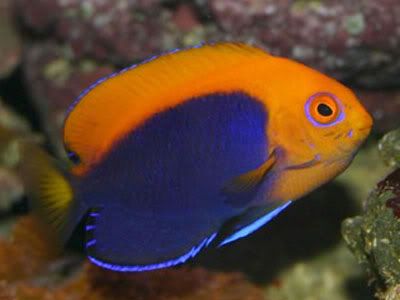
QUICK STATS
Minimum Tank Size: 30 gallons
Care Level: Moderate
Temperament: Semi-aggressive
Reef Compatible: With Caution
Water Conditions: 72-78F, dKH 8-12, pH 8.1-8.4, sg 1.020-1.025
Max. Size: 3"
Color Form: Blue, Orange
Diet: Omnivore
Compatibility: View Chart
Origin: Africa
Family: Pomacanthidae
OVERVIEW
The African Flameback Angelfish, also known as the African Pygmy Angelfish or Orangeback Angelfish, has striking contrasts of blue and orange-yellow colors. While the body is predominately blue, there is a broad and bright orange to yellow swatch from the head along the back to the tip of the dorsal fin. The caudal fin is yellow and somewhat transparent, which distinguishes it from the Brazilian Flameback Angelfish (also known as the Fireball Angelfish - Centropyge aurantonotus).
The African Flameback Angelfish requires a minimum of a 30 gallon tank with lots of hiding places and live rock for grazing. On occasion, this fish may nip at SPS and some species of polyp corals in the reef aquarium.
The diet of the African Flameback Angelfish should include Spirulina, marine algae, high-quality angelfish preparations, mysis or frozen shrimp, and other meaty foods.
Black Nox Angelfish (Centropyge nox)
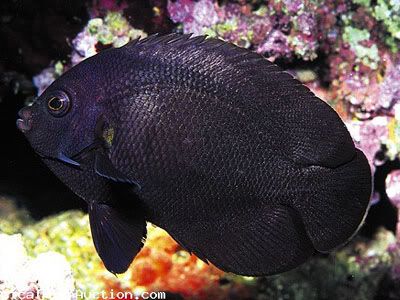
QUICK STATS
Minimum Tank Size: 30 gallons
Care Level: Moderate
Temperament: Semi-aggressive
Reef Compatible: With Caution
Water Conditions: 72-78F, dKH 8-12, pH 8.1-8.4, sg 1.020-1.025
Max. Size: 4"
Color Form: Black
Diet: Omnivore
Compatibility: View Chart
Origin: Indonesia, Vanuatu
Family: Pomacanthidae
OVERVIEW
The Black Nox Angelfish, also known as the Midnight Angelfish, is uniformly black over its entire body.
It requires at least a 30 gallon tank with lots of hiding places. The Black Nox Angelfish should be the only dwarf angelfish in the tank. It is not a good reef dweller and may eat soft coral polyps, clam mantles, and zoanthids.
It is very difficult to breed in an aquarium, and has no distinguishable differences in color between male to female.
The diet of the Black Nox Angelfish should include Spirulina, marine algae, mysis shrimp along with other meaty fare, and live rock for grazing.
Fisher's Angelfish (Centropyge fisheri)

QUICK STATS
Minimum Tank Size: 50 gallons
Care Level: Easy
Temperament: Moderate
Reef Compatible: With Caution
Water Conditions: 72-78F, dKH 8-12, pH 8.1-8.4, sg 1.021-1.025
Max. Size: 4"
Color Form: Blue, Tan
Diet: Omnivore
Compatibility: View Chart
Origin: Hawaii
Family: Pomacanthidae
OVERVIEW
The Fisher's Angelfish is also referred to as the Fisher's Pygmy or Fisher's Dwarf Angelfish, Orange Angelfish or Yellowtail Angelfish. It is only found in the Hawaiian Islands and along the Johnston Atoll. Fisher's Angelfish is predominantly orange with a thin sapphire-blue outline highlighting the belly and anal fin; the caudal fin is pale yellow.
A minimum of a 30 gallon tank with lots of hiding places and live rock for grazing will offer an environment in which to thrive. It should be the only dwarf angel in the tank. Not a good reef dweller, like most angels the Fisher's Angelfish will nip at stony and soft corals (sessile invertebrates) and clam mantles. It will also graze on diatoms on the tank surface.
It is hermaphroditic, very difficult to breed in an aquarium, and has no distinguishable differences in color between male to female.
The diet of the Fisher's Angelfish should include Spirulina, marine algae, high-quality angelfish preparations, mysis or frozen shrimp, and other meaty items.
Half Black Angelfish (Centropyge vroliki)
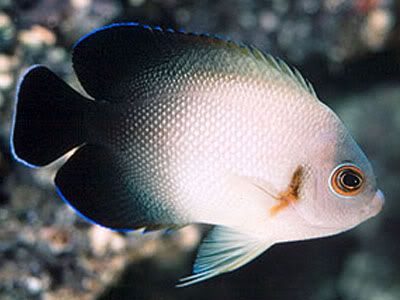
QUICK STATS
Minimum Tank Size: 30 gallons
Care Level: Moderate
Temperament: Semi-aggressive
Reef Compatible: With Caution
Water Conditions: 72-78F, dKH 8-12, pH 8.1-8.4, sg 1.020-1.025
Max. Size: 4"
Color Form: Black, White
Diet: Omnivore
Compatibility: View Chart
Origin: Fiji, Indonesia, Vanuatu
Family: Pomacanthidae
OVERVIEW
The Half Black Angelfish, like its name is half black and half pearled in coloration.
It requires at least a 30 gallon tank with lots of hiding places. The Half Black Angelfish should be the only dwarf angelfish in the tank. It is not a good reef dweller and may eat soft coral polyps, clam mantles, and zoanthids.
It is very difficult to breed in an aquarium, and has no distinguishable differences in color between male to female.
The diet of the Half Black Angelfish should include Spirulina, marine algae, mysis shrimp along with other meaty fare, and live rock for grazing.
Rusty Angelfish (Centropyge ferrugata)
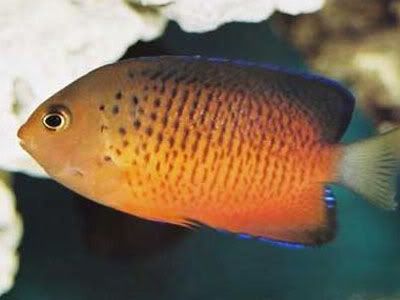
QUICK STATS
Minimum Tank Size: 30 gallons
Care Level: Moderate
Temperament: Semi-aggressive
Reef Compatible: With Caution
Water Conditions: 72-78F, dKH 8-12, pH 8.1-8.4, sg 1.020-1.025
Max. Size: 4"
Color Form: Blue, Red
Diet: Omnivore
Compatibility: View Chart
Origin: Indonesia
Family: Pomacanthidae
OVERVIEW
The Rusty Angelfish is aptly named for its predominate red or amber coloration punctuated with black dots that decrease in size from dorsal to anal and pelvic fins. The anal fin is dark and both the dorsal and anal fins are rimmed in bright, sapphire-blue.
The Rusty Angelfish requires at least a 30 gallon tank with large amounts of live rock for hiding and grazing. Not a good reef dweller, the Rusty Angelfish is prone to nip at stony and soft corals (sessile invertebrates) and clam mantles. It is best kept as the only Dwarf Angelfish in the tank.
The diet of the Rusty Angelfish should include Spirulina, marine algae, high-quality angelfish preparations, mysis shrimp, and other meaty items.
Singapore Angelfish (Chaetodontoplus mesoleucus)
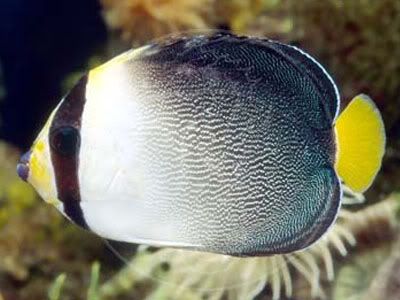
QUICK STATS
Minimum Tank Size: 50 gallons
Care Level: Difficult
Temperament: Semi-aggressive
Reef Compatible: With Caution
Water Conditions: 72-78F, dKH 8-12, pH 8.1-8.4, sg 1.020-1.025
Max. Size: 7"
Color Form: Black, Blue, White, Yellow
Diet: Omnivore
Compatibility: View Chart
Origin: Fiji, Indonesia
Family: Pomacanthidae
OVERVIEW
The Singapore Angelfish, also known as the Vermiculated Angelfish, has been likened to a butterflyfish in body structure. Blue lips and a yellow nose abruptly change to a black vertical band over the eyes, resembling a mask. The mask is bordered with another thin vertical band of yellow, followed by a wider vertical band of white with the body being primarily black. Dorsal and anal fins are outlined in brilliant sapphire-blue and the caudal fin is usually yellow but may be gray.
The Singapore Angelfish can be challenging to keep. Some acclimate well, while others hide constantly and do not eat. Providing a quietly-located aquarium with non-aggressive tank mates and plenty of hiding places may help. A minimum of a 50 gallon tank or larger provided with live rock for grazing will also help provide an optimal environment. The Singapore Angelfish is prone to nip at stony and soft corals (sessile invertebrates) and clam mantles. It will also graze on microalgae, filamentous algae, and diatoms.
The Singapore Angelfish is hermaphroditic, difficult to breed, and does not have distinguishable variations in color between male and female.
The diet should consist of mysis or finely shaved frozen shrimp, and other meaty items.
Yellow Angelfish (Centropyge heraldi)
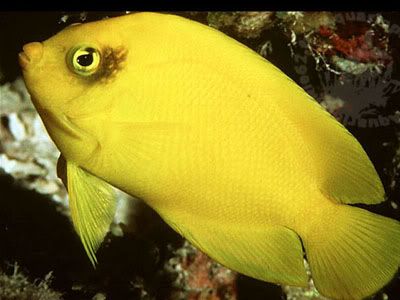
QUICK STATS
Minimum Tank Size: 30 gallons
Care Level: Moderate
Temperament: Semi-aggressive
Reef Compatible: With Caution
Water Conditions: 72-78F, dKH 8-12, pH 8.1-8.4, sg 1.020-1.025
Max. Size: 4"
Color Form: Orange, Blue
Diet: Omnivore
Compatibility: View Chart
Origin: Hawaii, Indonesia
Family: Pomacanthidae
OVERVIEW
The Yellow Angelfish from the Cook Islands is also known as the False Lemonpeel Angelfish, and is completely bright yellow in color. They resemble the Lemonpeel Angelfish with the exception of the blue markings around the eyes and the edges of the fins.
The Yellow Angelfish requires a 30 gallon or larger aquarium with hiding places and large amounts of live rock for grazing. In the reef aquarium, this species may nip at large-polyped stony corals, some soft coral polyps, and clam mantles.
The diet of the Yellow Angelfish should include Spirulina, marine algae, high-quality angelfish preparations, mysis or frozen shrimp, and other meaty items.
Potters Angel - Centropyge Potteri
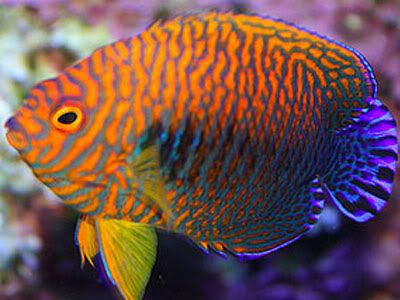
QUICKSTATS
Minimum Tank Size: 30 gallons
Care Level: Difficult
Temperament: Semi-aggressive
Reef Compatible: With Caution
Water Conditions: 72-78F, dKH 8-12, pH 8.1-8.4, sg 1.020-1.025
Max. Size: 4"
Color Form: Orange, Blue
Diet: Omnivore
Compatibility: View Chart
Origin: Eastern Pacific Ocean
Family: Pomacanthidae
OVERVIEW
Potter's Angels, Centropyge potteri, are often found living within the safety of live rock of the reefs found in the Eastern Pacific Ocean. Members of the genus Centropyge are referred to as Dwarf Angels because of their small size, generally three to six inches in length. Dwarf Angels are generally very peaceful fish with the exception of members of their own species and possibly genus if they look enough alike.
Provide Dwarf Angels with a balanced diet containing algae and sponge, which are readily available as prepared or frozen foods. Another addition to the aquarium that will benefit Dwarf Angels is live rock. It provides a great source of food as well as hiding places.
Flame Angelfish (Centropyge loriculus)

QUICK STATS
Minimum Tank Size: 30 gallons
Care Level: Moderate
Temperament: Semi-aggressive
Reef Compatible: With Caution
Water Conditions: 72-78F, dKH 8-12, pH 8.1-8.4, sg 1.020-1.025
Max. Size: 4"
Color Form: Blue, Orange, Yellow
Diet: Omnivore
Compatibility: View Chart
Origin: Cebu, Christmas Island, Marshall Islands, Tahiti, Vanuatu
Family: Pomacanthidae
OVERVIEW
The Flame Angelfish is a flashy addition to many aquariums. One of the most popular of the dwarf angelfish, the Flame Angelfish is a bold red/orange color with vertical black stripes highlighting the body and horizontal black stripes along the caudal portions of the blue-tipped dorsal and anal fins.
The Flame Angelfish requires at least a 30-gallon aquarium with lots of hiding places and live rock for grazing. The Flame Angelfish is prone to nip at stony and soft corals (sessile invertebrates) and clam mantles. If the Flame Angelfish is to be added to a peaceful community, it should be the last fish introduced. The Flame Angelfish adapts well to aquarium life, but should be kept in an established system and housed with dissimilar genera. The Flame Angel is very sensitive to elevated levels of copper, and should never be exposed to levels near or above 0.15 ppm.
The Flame Angelfish is hermaphroditic, very difficult to breed in an aquarium, and has no distinguishable differences in color between male to female.
The diet of the Flame Angelfish should consist of Spirulina, marine algae, high-quality angelfish preparations, mysis or frozen shrimp, and other high-quality meaty items.
There are slight differences in both coloration and markings of this species based on the location of collection. Flame Angelfish from the Central Pacific include both Marshall Islands and Christmas Island. Marshall Island Flame Angelfish are redder in color, with thicker black bars running vertically down the body. Christmas Island Flame Angelfish are normally red/orange coloration with thin black bars running vertically down the body. Flame Angelfish from Cebu are red/orange with undefined black bars and a tint of yellow in between the bars. Flame Angelfish from Tahiti are rarely collected and are blood red in coloration and possess very little to no yellow. It is important to note that these color descriptions are a general guideline. Please expect variation among each fish. The price differences between different varieties reflect the difference in collection, transportation and importation expense.
Coral Beauty Angelfish (Centropyge bispinosus)

QUICK STATS
Minimum Tank Size: 30 gallons
Care Level: Easy
Temperament: Semi-aggressive
Reef Compatible: With Caution
Water Conditions: 72-78F, dKH 8-12, pH 8.1-8.4, sg 1.020-1.025
Max. Size: 4"
Color Form: Blue, Orange, Yellow
Diet: Omnivore
Compatibility: View Chart
Origin: Fiji, Indonesia, Vanuatu
Family: Pomacanthidae
OVERVIEW
Very common on the Great Barrier Reef, the Coral Beauty Angelfish is also known as the Twospined or Dusky Angelfish. The body and head are a deep royal blue, highlighted with an iridescent orange to yellow. The Coral Beauty Angelfish is one of the easiest angels to care for.
It requires a 30 gallon or larger tank with lots of hiding places and live rock for grazing. Not a good reef dweller, the Coral Beauty Angelfish is prone to nip at stony and soft corals (sessile invertebrates).
The diet of the Coral Beauty Angelfish should consist of Spirulina, marine algae, high-quality angelfish preparations, mysis or frozen shrimp, and other quality meaty foods.
Bicolor Angelfish (Centropyge bicolor)

QUICK STATS
Minimum Tank Size: 30 gallons
Care Level: Moderate
Temperament: Semi-aggressive
Reef Compatible: With Caution
Water Conditions: 72-78F, dKH 8-12, pH 8.1-8.4, sg 1.020-1.025
Max. Size: 6"
Color Form: Blue, Yellow
Diet: Omnivore
Compatibility: View Chart
Origin: Fiji, New Caledonia, Papua New Guinea
Family: Pomacanthidae
OVERVIEW
Thought by many to be the most striking of the Centropyge group of dwarf or pygmy angelfish, the Bicolor Angelfish, also known as the Two-colored Angelfish or Oriole Angelfish, is a vibrant yellow on the anterior half of its body and a deep blue on the posterior half. A splash of deep blue extends upward vertically from the eye to the top of the head and the tail is yellow.
A minimum of a 30 gallon tank with lots of hiding places and live rock for grazing will offer an environment in which to thrive. Not a good reef dweller, the Bicolor Angelfish is prone to nip at stony and soft corals (sessile invertebrates) and clam mantles.
It is hermaphroditic, very difficult to breed in an aquarium, and has no distinguishable differences in color between male to female. The Bicolor Angelfish requires a diet of Spirulina, marine algae, high-quality angelfish preparations, and mysis or frozen shrimp.
Lemonpeel Angelfish (Centropyge flavissima)

QUICK STATS
Minimum Tank Size: 30 gallons
Care Level: Moderate
Temperament: Semi-aggressive
Reef Compatible: With Caution
Water Conditions: 72-78F, dKH 8-12, pH 8.1-8.4, sg 1.021-1.025
Max. Size: 6"
Color Form: Yellow
Diet: Omnivore
Compatibility: View Chart
Origin: Fiji, Vanuatu
Family: Pomacanthidae
OVERVIEW
The Lemonpeel Angelfish is a cheery yellow with sky-blue highlights on the lips, encircling the eyes, on the pectoral fins, and the tips of the dorsal, caudal, and anal fins. To avoid confusion with the False Lemonpeel Angelfish (C. heraldi) that lacks the blue highlights, this angelfish is also referred to as the True Lemonpeel Angelfish.
The Lemonpeel Angelfish requires a 30 gallon or larger aquarium with hiding places and large amounts of live rock to graze on the microalgae growth. It is very prone to nip at large-polyped stony corals and clam mantles. It is best not to keep Lemonpeel Angelfish with fish of the same genera.
The diet of the Lemonpeel Angelfish should include Spirulina, marine algae, high-quality angelfish preparations, mysis or frozen shrimp, and other meaty items. This angelfish requires more algae and seaweed in its diet than most angels.
Multicolor Angelfish (Centropyge multicolor)

QUICK STATS
Minimum Tank Size: 30 gallons
Care Level: Moderate
Temperament: Semi-aggressive
Reef Compatible: With Caution
Water Conditions: 72-78F, dKH 8-12, pH 8.1-8.4, sg 1.020-1.025
Max. Size: 3.5"
Color Form: Black, Blue, Orange, White, Yellow
Diet: Omnivore
Compatibility: View Chart
Origin: Marshall Islands
Family: Pomacanthidae
OVERVIEW
The Multicolor Angelfish, also known as the Pastel Pygmy Angelfish or Many-colored Angelfish, is pale peach-orange to yellow. Black speckles on a background of blue highlight an area just behind the eyes. The dorsal and anal fins are blue-black while the caudal fin is yellow. In bright contrast to its other colors, there is a horizontal swatch of silvery-white from mid-body to the caudal fin.
The Multicolor Angelfish needs a minimum of a 30 gallon tank with lots of hiding places and live rock for grazing on microalgae. It does best in subdued lighting, since in the wild, it is a deep-water swimmer. If the Multicolor Angelfish is to be housed with other dwarf angels, a 55 gallon or larger tank is required. Not a good reef dweller, the Multicolor Angelfish is prone to nip at stony and soft corals (sessile invertebrates) and clam mantles. It is sensitive to copper-based medications.
The diet of the Multicolor Angelfish should include Spirulina, high-quality angelfish preparations, mysis or frozen shrimp, and other high-quality meaty items.
Red Stripe Angelfish (Centropyge eibli)

QUICK STATS
Minimum Tank Size: 30 gallons
Care Level: Moderate
Temperament: Semi-aggressive
Reef Compatible: With Caution
Water Conditions: 72-78F, dKH 8-12, pH 8.1-8.4, sg 1.020-1.025
Max. Size: 6"
Color Form: Black, White
Diet: Omnivore
Compatibility: View Chart
Origin: Indonesia, Sri Lanka
Family: Pomacanthidae
OVERVIEW
The Red Stripe Angelfish is known by many names including the Eibl's Angelfish, Eibl's Pygmy Angelfish, Orangelined Angelfish, Blacktail Angelfish, and Eibl's Dwarf Angel. Its pearlescent body is highlighted with several vertical, evenly-spaced orange to red stripes. The very back of the body and caudal fin are black. A brilliant sapphire-blue stripe outlines the caudal fin.
Red Stripe Angelfish requires a 30 gallon or larger aquarium with large amounts of live rock for hiding and grazing. With a tendency to be docile, the Red Stripe Angelfish can become more assertive once established. It prefers not to be housed with other Dwarf Angels. It may occasionally nip at sessile invertebrates and clam mantles.
It is extremely difficult to breed in an aquarium, and there are no distinguishing characteristics that help differentiate males from females.
The diet of the Red Stripe Angelfish should include Spirulina, marine algae, mysis or frozen shrimp, and other meaty items.
Tibicen Angelfish (Centropyge tibicin)

QUICK STATS
Minimum Tank Size: 50 gallons
Care Level: Moderate
Temperament: Semi-aggressive
Reef Compatible: With Caution
Water Conditions: 72-78F, dKH 8-12, pH 8.1-8.4, sg 1.020-1.025
Max. Size: 8"
Color Form: Blue, Yellow
Diet: Omnivore
Compatibility: View Chart
Origin: Indonesia
Family: Pomacanthidae
OVERVIEW
The Tibicen Angelfish, also referred to as the Keyhole Angelfish or Melas Angelfish, is one of the largest of the Centropyge genus. Somewhat drab when compared to most other angelfish, the Tibicen Angelfish is primarily a dull blue to brownish-blue. The pelvic and lower portion of the anal fins are yellow. The egg-shaped, white vertical bar found in the mid-central body area gives it its name.
Provide a 50 gallon or larger tank for the Tibicen Angelfish. It should have large amounts of live rock for hiding and grazing. It may nip at stony and soft corals (sessile invertebrates) and clam mantles. It will also feed on filamentous algae and diatoms.
It is hermaphroditic, very difficult to breed in an aquarium, and has no distinguishable differences in color between male to female.
Its diet should also include Spirulina, marine algae, high-quality angelfish preparations, mysis or frozen shrimp, and other meaty items. Feed 2-3 times daily.
Flameback Angelfish (African) (Centropyge acanthops)

QUICK STATS
Minimum Tank Size: 30 gallons
Care Level: Moderate
Temperament: Semi-aggressive
Reef Compatible: With Caution
Water Conditions: 72-78F, dKH 8-12, pH 8.1-8.4, sg 1.020-1.025
Max. Size: 3"
Color Form: Blue, Orange
Diet: Omnivore
Compatibility: View Chart
Origin: Africa
Family: Pomacanthidae
OVERVIEW
The African Flameback Angelfish, also known as the African Pygmy Angelfish or Orangeback Angelfish, has striking contrasts of blue and orange-yellow colors. While the body is predominately blue, there is a broad and bright orange to yellow swatch from the head along the back to the tip of the dorsal fin. The caudal fin is yellow and somewhat transparent, which distinguishes it from the Brazilian Flameback Angelfish (also known as the Fireball Angelfish - Centropyge aurantonotus).
The African Flameback Angelfish requires a minimum of a 30 gallon tank with lots of hiding places and live rock for grazing. On occasion, this fish may nip at SPS and some species of polyp corals in the reef aquarium.
The diet of the African Flameback Angelfish should include Spirulina, marine algae, high-quality angelfish preparations, mysis or frozen shrimp, and other meaty foods.
Black Nox Angelfish (Centropyge nox)

QUICK STATS
Minimum Tank Size: 30 gallons
Care Level: Moderate
Temperament: Semi-aggressive
Reef Compatible: With Caution
Water Conditions: 72-78F, dKH 8-12, pH 8.1-8.4, sg 1.020-1.025
Max. Size: 4"
Color Form: Black
Diet: Omnivore
Compatibility: View Chart
Origin: Indonesia, Vanuatu
Family: Pomacanthidae
OVERVIEW
The Black Nox Angelfish, also known as the Midnight Angelfish, is uniformly black over its entire body.
It requires at least a 30 gallon tank with lots of hiding places. The Black Nox Angelfish should be the only dwarf angelfish in the tank. It is not a good reef dweller and may eat soft coral polyps, clam mantles, and zoanthids.
It is very difficult to breed in an aquarium, and has no distinguishable differences in color between male to female.
The diet of the Black Nox Angelfish should include Spirulina, marine algae, mysis shrimp along with other meaty fare, and live rock for grazing.
Fisher's Angelfish (Centropyge fisheri)

QUICK STATS
Minimum Tank Size: 50 gallons
Care Level: Easy
Temperament: Moderate
Reef Compatible: With Caution
Water Conditions: 72-78F, dKH 8-12, pH 8.1-8.4, sg 1.021-1.025
Max. Size: 4"
Color Form: Blue, Tan
Diet: Omnivore
Compatibility: View Chart
Origin: Hawaii
Family: Pomacanthidae
OVERVIEW
The Fisher's Angelfish is also referred to as the Fisher's Pygmy or Fisher's Dwarf Angelfish, Orange Angelfish or Yellowtail Angelfish. It is only found in the Hawaiian Islands and along the Johnston Atoll. Fisher's Angelfish is predominantly orange with a thin sapphire-blue outline highlighting the belly and anal fin; the caudal fin is pale yellow.
A minimum of a 30 gallon tank with lots of hiding places and live rock for grazing will offer an environment in which to thrive. It should be the only dwarf angel in the tank. Not a good reef dweller, like most angels the Fisher's Angelfish will nip at stony and soft corals (sessile invertebrates) and clam mantles. It will also graze on diatoms on the tank surface.
It is hermaphroditic, very difficult to breed in an aquarium, and has no distinguishable differences in color between male to female.
The diet of the Fisher's Angelfish should include Spirulina, marine algae, high-quality angelfish preparations, mysis or frozen shrimp, and other meaty items.
Half Black Angelfish (Centropyge vroliki)

QUICK STATS
Minimum Tank Size: 30 gallons
Care Level: Moderate
Temperament: Semi-aggressive
Reef Compatible: With Caution
Water Conditions: 72-78F, dKH 8-12, pH 8.1-8.4, sg 1.020-1.025
Max. Size: 4"
Color Form: Black, White
Diet: Omnivore
Compatibility: View Chart
Origin: Fiji, Indonesia, Vanuatu
Family: Pomacanthidae
OVERVIEW
The Half Black Angelfish, like its name is half black and half pearled in coloration.
It requires at least a 30 gallon tank with lots of hiding places. The Half Black Angelfish should be the only dwarf angelfish in the tank. It is not a good reef dweller and may eat soft coral polyps, clam mantles, and zoanthids.
It is very difficult to breed in an aquarium, and has no distinguishable differences in color between male to female.
The diet of the Half Black Angelfish should include Spirulina, marine algae, mysis shrimp along with other meaty fare, and live rock for grazing.
Rusty Angelfish (Centropyge ferrugata)

QUICK STATS
Minimum Tank Size: 30 gallons
Care Level: Moderate
Temperament: Semi-aggressive
Reef Compatible: With Caution
Water Conditions: 72-78F, dKH 8-12, pH 8.1-8.4, sg 1.020-1.025
Max. Size: 4"
Color Form: Blue, Red
Diet: Omnivore
Compatibility: View Chart
Origin: Indonesia
Family: Pomacanthidae
OVERVIEW
The Rusty Angelfish is aptly named for its predominate red or amber coloration punctuated with black dots that decrease in size from dorsal to anal and pelvic fins. The anal fin is dark and both the dorsal and anal fins are rimmed in bright, sapphire-blue.
The Rusty Angelfish requires at least a 30 gallon tank with large amounts of live rock for hiding and grazing. Not a good reef dweller, the Rusty Angelfish is prone to nip at stony and soft corals (sessile invertebrates) and clam mantles. It is best kept as the only Dwarf Angelfish in the tank.
The diet of the Rusty Angelfish should include Spirulina, marine algae, high-quality angelfish preparations, mysis shrimp, and other meaty items.
Singapore Angelfish (Chaetodontoplus mesoleucus)

QUICK STATS
Minimum Tank Size: 50 gallons
Care Level: Difficult
Temperament: Semi-aggressive
Reef Compatible: With Caution
Water Conditions: 72-78F, dKH 8-12, pH 8.1-8.4, sg 1.020-1.025
Max. Size: 7"
Color Form: Black, Blue, White, Yellow
Diet: Omnivore
Compatibility: View Chart
Origin: Fiji, Indonesia
Family: Pomacanthidae
OVERVIEW
The Singapore Angelfish, also known as the Vermiculated Angelfish, has been likened to a butterflyfish in body structure. Blue lips and a yellow nose abruptly change to a black vertical band over the eyes, resembling a mask. The mask is bordered with another thin vertical band of yellow, followed by a wider vertical band of white with the body being primarily black. Dorsal and anal fins are outlined in brilliant sapphire-blue and the caudal fin is usually yellow but may be gray.
The Singapore Angelfish can be challenging to keep. Some acclimate well, while others hide constantly and do not eat. Providing a quietly-located aquarium with non-aggressive tank mates and plenty of hiding places may help. A minimum of a 50 gallon tank or larger provided with live rock for grazing will also help provide an optimal environment. The Singapore Angelfish is prone to nip at stony and soft corals (sessile invertebrates) and clam mantles. It will also graze on microalgae, filamentous algae, and diatoms.
The Singapore Angelfish is hermaphroditic, difficult to breed, and does not have distinguishable variations in color between male and female.
The diet should consist of mysis or finely shaved frozen shrimp, and other meaty items.
Yellow Angelfish (Centropyge heraldi)

QUICK STATS
Minimum Tank Size: 30 gallons
Care Level: Moderate
Temperament: Semi-aggressive
Reef Compatible: With Caution
Water Conditions: 72-78F, dKH 8-12, pH 8.1-8.4, sg 1.020-1.025
Max. Size: 4"
Color Form: Orange, Blue
Diet: Omnivore
Compatibility: View Chart
Origin: Hawaii, Indonesia
Family: Pomacanthidae
OVERVIEW
The Yellow Angelfish from the Cook Islands is also known as the False Lemonpeel Angelfish, and is completely bright yellow in color. They resemble the Lemonpeel Angelfish with the exception of the blue markings around the eyes and the edges of the fins.
The Yellow Angelfish requires a 30 gallon or larger aquarium with hiding places and large amounts of live rock for grazing. In the reef aquarium, this species may nip at large-polyped stony corals, some soft coral polyps, and clam mantles.
The diet of the Yellow Angelfish should include Spirulina, marine algae, high-quality angelfish preparations, mysis or frozen shrimp, and other meaty items.
Potters Angel - Centropyge Potteri

QUICKSTATS
Minimum Tank Size: 30 gallons
Care Level: Difficult
Temperament: Semi-aggressive
Reef Compatible: With Caution
Water Conditions: 72-78F, dKH 8-12, pH 8.1-8.4, sg 1.020-1.025
Max. Size: 4"
Color Form: Orange, Blue
Diet: Omnivore
Compatibility: View Chart
Origin: Eastern Pacific Ocean
Family: Pomacanthidae
OVERVIEW
Potter's Angels, Centropyge potteri, are often found living within the safety of live rock of the reefs found in the Eastern Pacific Ocean. Members of the genus Centropyge are referred to as Dwarf Angels because of their small size, generally three to six inches in length. Dwarf Angels are generally very peaceful fish with the exception of members of their own species and possibly genus if they look enough alike.
Provide Dwarf Angels with a balanced diet containing algae and sponge, which are readily available as prepared or frozen foods. Another addition to the aquarium that will benefit Dwarf Angels is live rock. It provides a great source of food as well as hiding places.